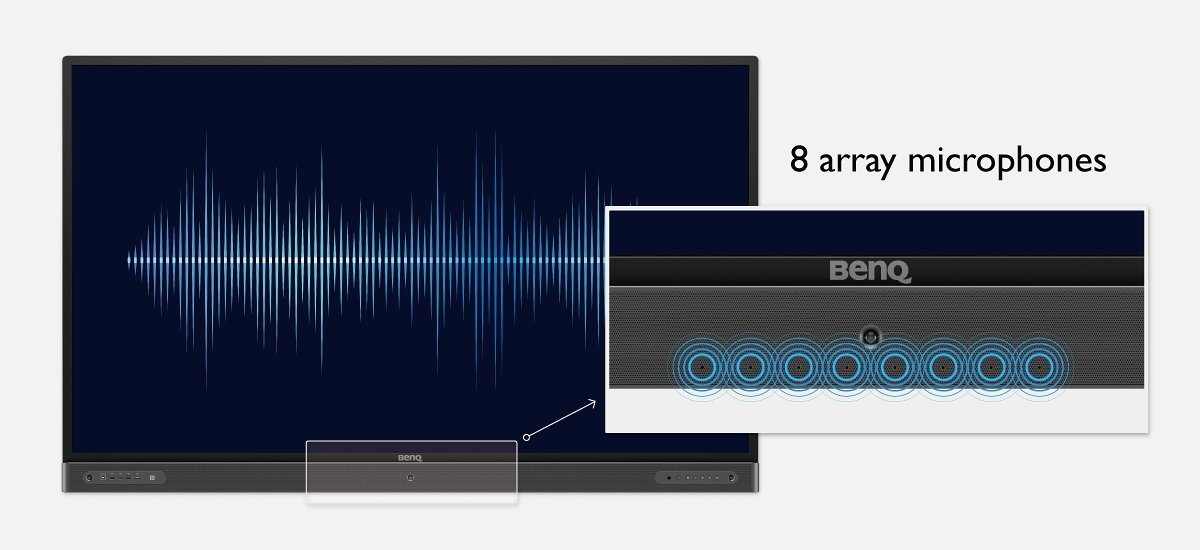How to Ensure Great Audio in Your Hybrid Classroom? Array Microphones Are the Answer
- BenQ
- 2021-05-07
Perhaps the greatest challenge for today’s education system has been the move to a hybrid teaching environment. With half of their students in the class and the other half at home, teachers are faced with a dilemma. How to keep children safe while delivering lessons that perform equally well with students in class and those at home. The critical factor – audio.
Confusing, Inconsistent, or scratchy audio quickly leads to frustration from students listening at home who can’t follow the lesson. The answer – the same technology found on your cell phone in your pocket – the array microphone. This article covers:
An array microphone can enable remote students to hear the teacher talking from nearly location in the classroom. A simple yet powerful technology, an array mic is essentially a group of individual microphones all working in tandem, coordinated by software. So how does that differ from a traditional microphone?
Single microphones are ideal for recording a single voice that also is close by and relatively stationary, or directly attached to the teacher. The challenge is when the teacher is not near the microphone – or, in the case of active classrooms, there is too much ambient noise, so the teacher’s voice (or a student question) would be very difficult to perceive over the noise of a talkative classroom.

An array microphone solves these problems by using two or more single mics in tandem. The result is a “smart” microphone that provides superior recording quality in a dynamic environment like a classroom. Let’s explore how it can follow and capture a teacher’s voice when they are moving.
An array mic is why your iPhone can deliver a clear call on a windy day, and is the ideal technology for recording a teacher’s voice at a consistent volume as it moves around the room. They can sense and block ambient noise, like a room full of talkative students.
Each mic in the array is listening for the loudest sound in the classroom, namely the teacher’s voice. The software in the array determines which mic has the best pickup on that loudest sound and turns up the sensitivity of that individual mic. Meanwhile, the software directs the other mics to listen for lower-volume ambient noise.
Here’s the cool part. The array mic software subtracts the ambient noise from the overall sound of the classroom, much like the noise-cancelling headphones you’d wear on a plane. As a result, the student listening from home can hear the teacher’s voice with crystal clarity!

Devices that use array microphones record excellent sound exceptionally well, and the more microphones, the better the audio and comprehension in remote learning. For example, an iPhone 11 has 4 mics built-in to its array to capture your voice – and assumes you are within a few feet of your phone.
By comparison, the best classroom interactive flat panel will have up to 8 mics built into its array. This enables the teacher to move around freely in front of the display – and can capture the teacher’s voice (and student questions) from up to 4,5 meter away, or directly to the side of the board. With eight microphones built into the display, the software can easily track the teacher all around the room, without adding expensive infrastructure.

Looking to Increase Teacher Accessibility via Electronic Communication?
If you are looking to improve hybrid classroom learning, then you may want to look an interactive display that can effectively capture and record the teacher’s voice from nearly anywhere in the room.
While educational technology isn’t a panacea for the problems educators face today, new innovations such as array microphones can be easily incorporated into a classroom display – without blowing the budget.
If you want to see what an array microphone system can do for your teacher recording, click below to check out the new BenQ Board with an integrated eight microphone system – or fill out the form below to setup a virtual or in-person demonstration so you can see for yourself – and your teachers – why BenQ is one of the fastest growing worldwide classroom display in public and private schools.
